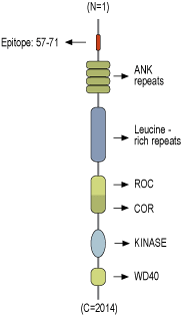Overview
- Peptide (C)EIHTAYKQRNLSRAR, corresponding to amino acid residues 57-71 of mouse LRRK1 (Accession Q3UHC2). N-terminus.

 Western blot analysis of rat (lanes 1 and 3) and mouse (lanes 2 and 4) brain lysates:1,2. Anti-LRRK1 Antibody (#ANR-101), (1:200).
Western blot analysis of rat (lanes 1 and 3) and mouse (lanes 2 and 4) brain lysates:1,2. Anti-LRRK1 Antibody (#ANR-101), (1:200).
3,4. Anti-LRRK1 Antibody, preincubated with LRRK1 Blocking Peptide (#BLP-NR101).
- Civiero, L. et al. (2012) PLoS One 7, e43472.
- Ishikawa, K. et al. (2012) Mol. Biol. Cell 1294, 306.
- Schulte, E.C. et al. (2014) Neurogenetics 15, 49.
- Dachsel, J.C. et al. (2010) Mech. Ageing Dev. 131, 210.
- Xing, W. et al. (2013) J. Bone Miner. Res. 28, 1962.
Leucine-rich repeat kinase 1 (LRRK1) is a member of the ROCO protein kinase superfamily.
ROCO is a family of multidomain proteins characterized by the presence of tandem ROC (Ras of Complex Proteins) and COR (C-terminal of ROC) domains. In humans, ROCO proteins comprises four members: Leucine-rich repeat kinase 1 (LRRK1), Leucine-rich repeat kinase 2 (LRRK2), Death-associated kinase 1 (DAPK1) and Malignant fibrous histiocytoma amplified sequence 1 (MFASH1). In addition, LRRK1 contains a GTPase domain and MAPKKK-like kinase domain. LRRK1 structure includes a serine-threonine kinase domain C-terminal of ROC-COR, and leucine-rich and ankyrin-like repeats at the N-terminus1.
LRRK1 can form hetero- and homo-dimers and it seems that the dimer is the functional unit of the protein. LRRK1 kinase activity is stimulated by GTP binding to the Roc domain and the protein is basally phosphorylated1.
LRRK1 is involved in the trafficking of activated epidermal growth factor receptor (EGFR). The N-terminus of LRRK1 interacts with Grb2, an adaptor protein for EGFR, and forms a complex with EGFR via Grb2 in response to EGF stimulation2.
Data suggest that variants in LRRK1 in addition to LRRK2, may have a role in the genetic foundation of Parkinson's disease3. Also, the dimerization of LRRK1 with LRRK2 may influence the age of symptomatic expression in LRRK2-parkinsonism patients4.
LRRK1 knockout mice provide evidence that LRRK1 has an important role in negative regulation of bone mass in part through modulating the c-Src signaling pathway in mice5.
Application key:
Species reactivity key:
Alomone Labs is pleased to offer a highly specific antibody directed against an epitope of mouse LRRK1. Anti-LRRK1 Antibody (#ANR-101) can be used in western blot analysis. It has been designed to recognize LRRK1 from rat and mouse samples. The antibody is not recommended to be used on human samples.
